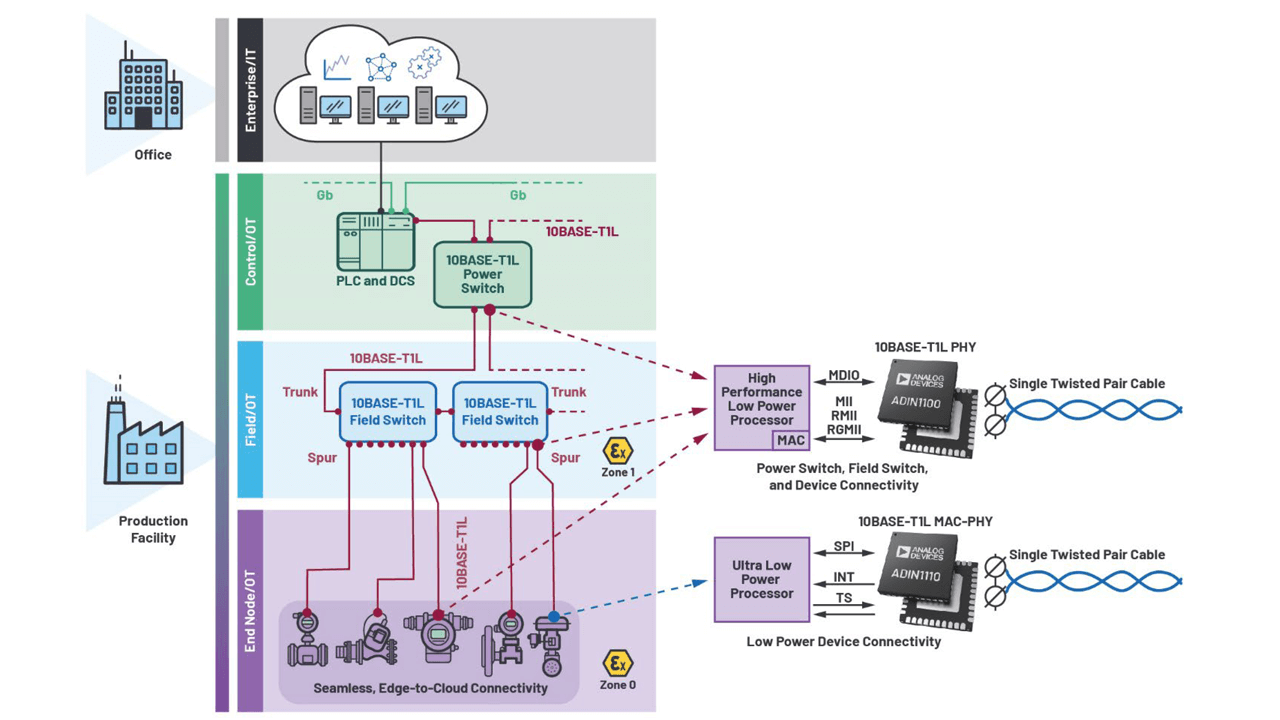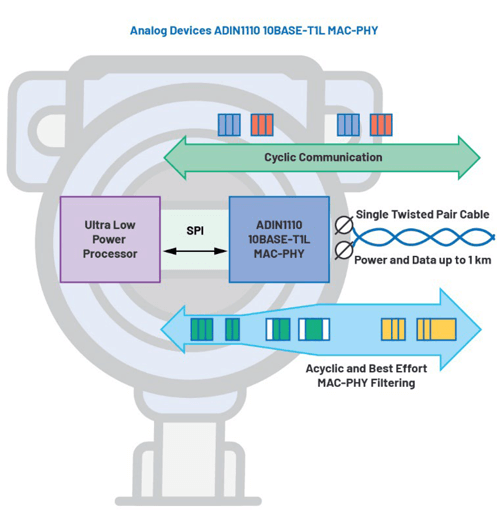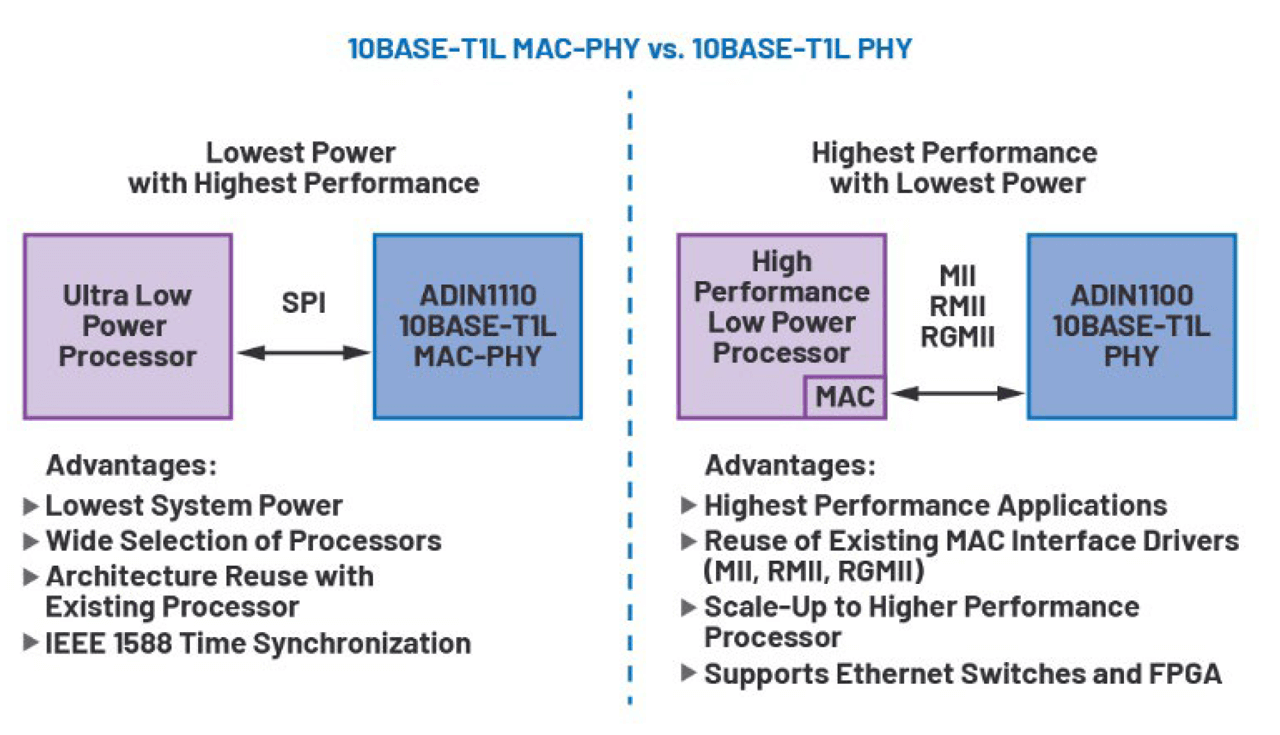TechnologySeptember 15, 2022
10BASE-T1L MAC-PHY for Low Power Ethernet Connectivity

A 10 Mb Ethernet physical layer (10BASE-T1L) combined with power delivery (Engineered Power/PoDL/SPoE) on two wires, up to 1 km, will enable new types of Ethernet-connected devices that generate higher value insights that are now more accessible via a converted IT/OT Ethernet network.
This article explains how to connect to an increased number of low power field or edge devices with a 10BASE-T1L MAC-PHY. It will also detail when to use the MAC-PHY vs. a 10BASE-T1L PHY and how these systems meet the requirements of tomorrow’s Ethernet-connected manufacturing and building installations.
Background
Single-pair Ethernet 10BASE-T1L use cases, including Ethernet-APL, continue to expand across process, factory, and building automation applications driven by the requirement to connect more devices to Ethernet networks. With more devices connected, richer datasets are made available to the higher level management systems, leading to significant increases in productivity while reducing operating costs and energy consumption.
The vision of Ethernet to the field or edge is to connect all sensors and actuators to a converged IT/OT network. To achieve this vision there are system engineering challenges, as some of these sensors are limited in power and space. There is a growing market of low power and ultra low power microcontrollers with significant internal memory capabilities for sensor and actuator applications.
But most of these processors have one thing in common—with no integrated Ethernet MAC, they don’t support an MII, RMII, or RGMII media independent (Ethernet) interface. A traditional PHY cannot be connected to these processors.

A 10BASE-T1L MAC-PHY significantly reduces the power and complexity of devices with advanced packet filtering.
Why Use a 10BASE-T1L MAC-PHY
To enable long range Ethernet connectivity to an increased number of lower power devices, a 10BASE-T1L MAC-PHY is required. With a 10BASE-T1L MAC-PHY, Ethernet connectivity is provided to a processor via SPI, reducing the burden on the processor by removing the need for an integrated MAC.
The MAC functionality is now integrated directly with the 10BASE-T1L PHY. A 10BASE-T1L MAC-PHY provides device architects increased flexibility and choice by enabling a variety of ultra low power processors. By optimizing the application partitioning, a 10BASE-T1L MAC-PHY enables lower power field devices for Zone 0 intrinsically safe deployment through what is referred to in the process industry as Ethernet-APL. Within intelligent building applications, a MAC-PHY will enable more lower power devices to be connected to an Ethernet network. Intelligent building applications include HVAC systems, fire safety systems, access control, IP cameras, elevator systems, and condition monitoring.

A 10BASE-T1L MAC-PHY significantly reduces the power and complexity of devices with advanced packet filtering.
10BASE-T1L MAC-PHY Advanced Packet Filtering
The integration of the MAC functionality with a 10BASE-T1L PHY provides new features to optimize Ethernet traffic on the network. A 10BASE-T1L MAC-PHY with advanced packet filtering will significantly reduce the overhead of handling broadcast and multicast traffic, while freeing the processor from this task. To filter by the destination MAC address is key.
Instead of just a single MAC address, a MAC-PHY can support filtering using up to 16 unicast or multicast MAC addresses. In addition, address masking is supported for two MAC addresses. This gives a great degree of freedom, filtering for the device address as well as commonly supported multicast addresses such as LLDP (Link Layer Discovery Protocol).
By supporting an additional queue for higher priorities, some messages can be prioritized and therefore get improved latency and robustness. The priority of a frame can be identified by the MAC filtering table. For example, broadcast messages can be fed into a lower priority queue and unicast into the higher priority queue to prevent the receiver from being overloaded by a broadcast storm or traffic surge. These MAC-PHY filtering features enable netload robust devices. Frame statistics are also gathered by the MAC to assist in monitoring the network traffic and the quality of the link.
The MAC in the MAC-PHY also supports IEEE 1588, and therefore 802.1AS time synchronization as required in process automation. The MAC-PHY provides support for a synchronized counter, timestamping of received messages and timestamp capture for transmit messages. This greatly reduces the complexity of the software design, as there is no further hardware support needed to implement time synchronization beyond the MAC-PHY itself.
The MAC can generate an output waveform timed to the synchronized counter, which may be used to synchronize external application-level operations. The SPI interface supports the Open Alliance 10BASE-T1x MAC-PHY Serial Interface. The Open Alliance SPI is a new and very effective SPI protocol designed specifically for use with a MAC-PHY.

Comparison of the advantages of a MAC-PHY vs. a PHY for 10BASE-T1L connectivity.
When to Use a 10BASE-T1L MAC-PHY and a 10BASE-T1L PHY
Both a 10BASE-T1L PHY and a 10BASE-T1L MAC-PHY bring significant advantages in different use cases. For power critical applications, a 10BASE-T1L MAC-PHY enables lower system power by providing more flexibility on the choice of host processor to include ultra low power processors that do not have an integrated MAC.
When upgrading an existing device to add Ethernet connectivity, a 10BASE-T1L MAC-PHY provides a route to reusing the existing processor and adding Ethernet connectivity via an SPI port, removing the requirement to move to a larger processor with an integrated MAC.
For high performance applications where a field or edge device requires a high performance processor that may already have an integrated MAC, a 10BASE-T1L PHY with MII, RMII, and RGMII MAC interfaces allows a 10BASE-T1L PHY to be quickly developed. This is done by reusing existing MAC interface drivers to add Ethernet connectivity.
Tomorrow’s Ethernet-Connected Process Installations
With the availability of both 10BASE-T1L PHYs (ADIN1100) and 10BASE-T1L MAC-PHYs (ADIN1110), device architects now have increased flexibility to meet the requirements of tomorrow’s Ethernet-connected manufacturing installations.
Ultra low power devices and high performance devices can be deployed on the same Ethernet network and comply with strict maximum power limitations for hazardous area use case requirements.
10BASE-T1L power switches and 10BASE-T1L field switches require robust, low power 10BASE-T1L PHYs to be used with Industrial Ethernet switches to deploy a trunk-and-spur network topology that provides both power and data over a single twisted pair cable, including hazardous area use cases.
Field device connectivity requires both 10BASE-T1L PHYs and 10BASE-T1L MAC-PHYs to enable Ethernet connectivity to a wide range of field devices.
Higher power field devices, including flowmeters, will use a high performance processor, with an integrated MAC with a 10BASE-T1L PHY. Lower power field devices, including temperature sensors with an ultra low power processor that does not have an integrated MAC, will use a 10BASE-T1L MAC-PHY for Ethernet connectivity via an SPI interface to the processor.
Comparison of 10BASE-T1L PHY and 10BASE-T1L MAC-PHY Key Features
The ADIN1110, ADI’s 10BASE-T1L MAC-PHY, enables lower power Ethernet connectivity via an SPI interface to a host processor with only 42 mW of power consumption. The ADIN1110 supports the Open Alliance 10BASE-T1x MAC-PHY Serial Interface for full-duplex SPI communications at 25 MHz clock speed.
The ADIN1100, ADI’s 10BASE-T1L PHY, enables low power Ethernet connectivity via MII, RMII, and RGMII MAC interfaces to a host processor with only 39 mW of power consumption—see Table 1 for a comparison of the ADIN1100 10BASE-T1L PHY and ADIN1110 10BASE-T1L MAC-PHY. Both products are based on 10BASE-T1L core capability of a full-duplex, DC balanced, point-to-point communication scheme with PAM 3 modulation at a 7.5 MBd symbol rate with 4B3T coding.
10BASE-T1L supports two amplitude modes: 2.4 V peak-to-peak up to 1000 m cable and 1.0 V peak-to-peak at a reduced distance. The 1.0 V peak-to-peak amplitude mode means that this new physical layer technology can also be used in the environment of explosion proof (Ex-proof) systems and meets the strict maximum energy restrictions.
Summary
A 10 Mb Ethernet physical layer (10BASE-T1L) combined with power delivery (Engineered Power/PoDL/SPoE) on two wires, up to 1 km, will enable new types of Ethernet-connected devices that generate higher value insights that are now more accessible via a converted IT/OT Ethernet network.
These new insights will drive higher productivity and reduce energy consumption in process and factory automation applications. In building automation applications these new insights will enable higher levels of energy efficiency, safety, and comfort. As a result, a 10BASE-T1L MAC-PHY will accelerate lower power device availability.


